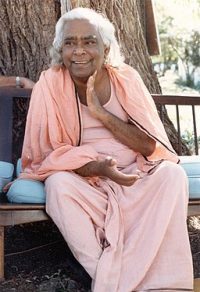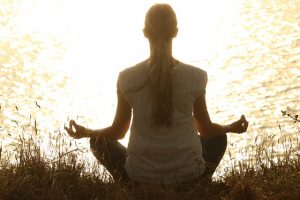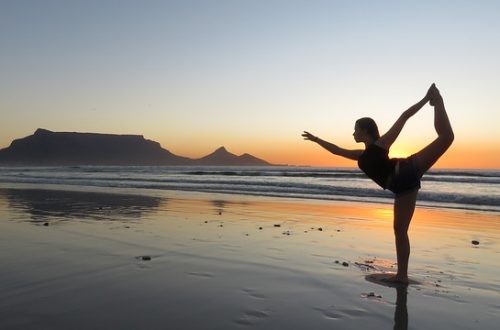
Swami Vishnudevananda and the Sivananda Yoga Vedanta Centers
A Short Presentation of the Sivananda Yoga Vedanta Centers founded by Swami Vishnudevananda (1927-1993).
1957 – Swami Vishnudevananda comes to the West
The book Yoga was first published from the Sivananda Yoga Vedanta Center in Canada in 1983. Unfortunately, the book does not reveal who the people depicted with Yoga-āsana are. Here I would like to briefly introduce the work of the Sivananda Yoga Vedanta Centers that nowadays are distributed all over the world. The first such center was founded by Swami Vishnudevananda in 1959 in Montreal, Canada. Vishnudevananda had lived, learned and worked with Swami Sivananda Saraswati for 10 years. In 1957 he was sent by his teacher to the West. Interesting are the words Sivananda said:
Go, people wait. Many souls from the East are now born again in the West. Go and bring back the consciousness dormant in her memory and lead them back to the path of yoga. (Book “Yoga”, p. 7)
1959 – 1993 The Development of the Sivananda Yoga Vedanta Centers
The mission of Swami Vishnudevananda was now to make the traditional contents of yoga accessible to the people of the West. He put out two very simple key points. These are still to be found on the website of the Sivananda Yoga Vedanta Centers as essential teaching content. These are the five principles of practice, asana, pranayama, relaxation, nutrition and meditation. Lucy Lidell explains these principles in the book “Yoga” as follows (p. 21):
Proper relaxation: tensions in the muscles dissolve and your whole body comes to rest. You will wake up like after a good night’s sleep. You will be more active. You can save your energy, shake off fears and worries.
Proper exercises: Yoga postures or āsana systematically affect the whole body. Muscles and ligaments are stretched as well as strengthened; the spine and joints remain flexible, the circulation is stimulated.

Proper breathing: You should breathe fully and rhythmically, filling the whole lung, not just a part, with air and thus you increase the absorption of oxygen. Yoga breathing exercises or pranayama teach to recharge the body and control the mind by regulating the flow of the prana. Prana is the life force that is conserved in the chakras.
Proper nutrition: is composed of natural foods, in a nutritious and balanced way. It keeps the body loose and supple, calms the mind and provides enough resistance to disease.
Positive Thinking and Meditation: Meditation helps you to dissipate negative thoughts, to soothe the mind, and finally to transcend all thoughts.
1994 – today: Yoga accordingly individual needs
Further, Swami Vishnudevananda taught the completeness of the four yoga paths Karma Yoga, Bhakti Yoga, Jnana Yoga and Raja Yoga. In general, most yoga styles today focus on the physical exercises of Hatha Yoga which is a part of the eight-level Raja Yoga system. Visitors to a Sivananda Yoga Vedanta Center can now get to know all four of the yoga paths and, finally, personalize their own practice. On the website of the center of Montreal quoted above is the following explanation for the four yoga threads:
Karma Yoga (selfless service): Also known as the Yoga of action, Karma Yoga is the core of the entire Sivananda Organization. Put in a simple way, it is the path of Yoga where one serves with no expectation or reward. The duties are performed with the feeling that one is serving God through humanity. Karma Yoga is meant to purify the ego, for as one serves, one becomes an instrument in the hands of God, losing his/her identification with the work done and forgetting about his/her own wants and needs.
Bhakti Yoga (Devotion): In Swami Sivananda’s words, Bhakti Yoga is the easiest and surest way to attain God-Realization in this present age. Through prayers, chants and worship, one turns his/her emotions into devotion, developing an unconditional love toward all creation, for God is beheld everywhere.

Rāja Yoga (Meditation): Rāja Yoga deals with the control of the mind through the study and understanding of its workings. A set of practices is prescribed to discipline and control the different components of the human being: the body, prāṇā (vital energy) and the mind. With the tools provided by these practices, one develops will-power and clarity of mind.
Jñāna Yoga (Knowledge): Jñāna Yoga is the intellectual approach of Yoga. Through the practice of Vedānta and a deep philosophical enquiry, one investigates the nature of the Self. This path is said to be the most difficult one, for the aspirant needs some previous qualifications as well as great will power and courage to face the Truth.
The work of the Sivananda Yoga Vedanta Centers has continued to develop on these pillars of content. There are yoga classes, meditation and Ayurveda courses, children’s programs and in certain centers one-month yoga teacher trainings. Also important are the yoga camps, where people spend their holidays practicing yoga and getting to know a simple lifestyle. These retreats are designed with a relatively strict rhythm throughout the day, which has, however, a very regenerating effect on the whole person.
Sivananda Yoga and the Yoga Online Exhibition
In my opinion, the book “Yoga” seems to have been replaced by some more modern works. It shows especially aesthetic images of Yoga-āsana. This in terms of the art of photography, as well as the precise shaping of the body in the individual yoga postures. A characteristic grace is expressed in many of the pictures. That’s why I’ve included a small selection of its images in the Yoga Online Exhibition.
Update (19-08-10): The following video was created in honour of the 50th anniversary of the Shivananda Yoga Ashram on the Bahamas. His biographer Kamala speaks about the life of Swami Vishnudevananda.
Image source (19-03-20): featured image-wikipedia, Proper nutrition-image of Deborah Breen Whiting on pixabay, meditation-image of pexels on pixabay




